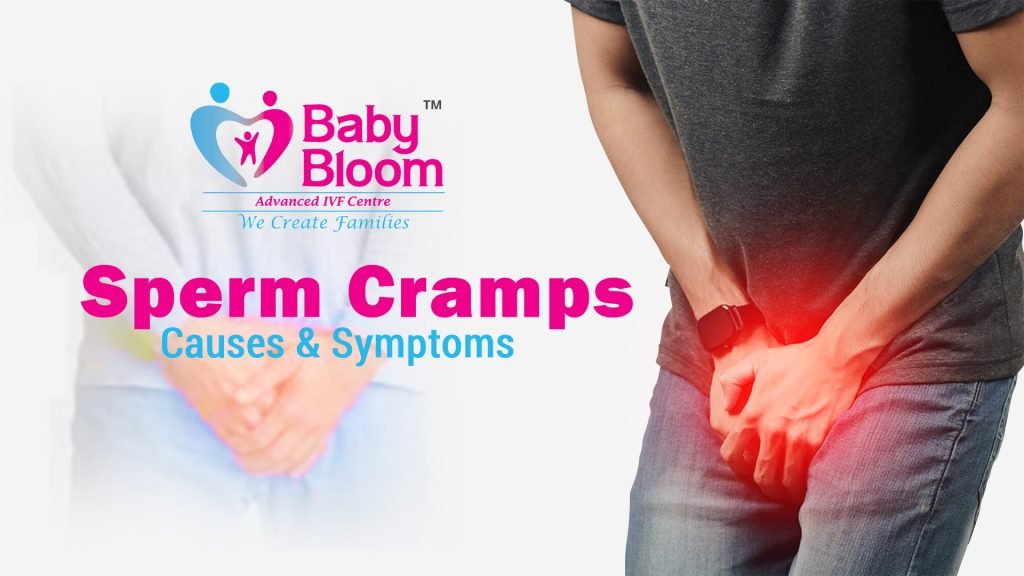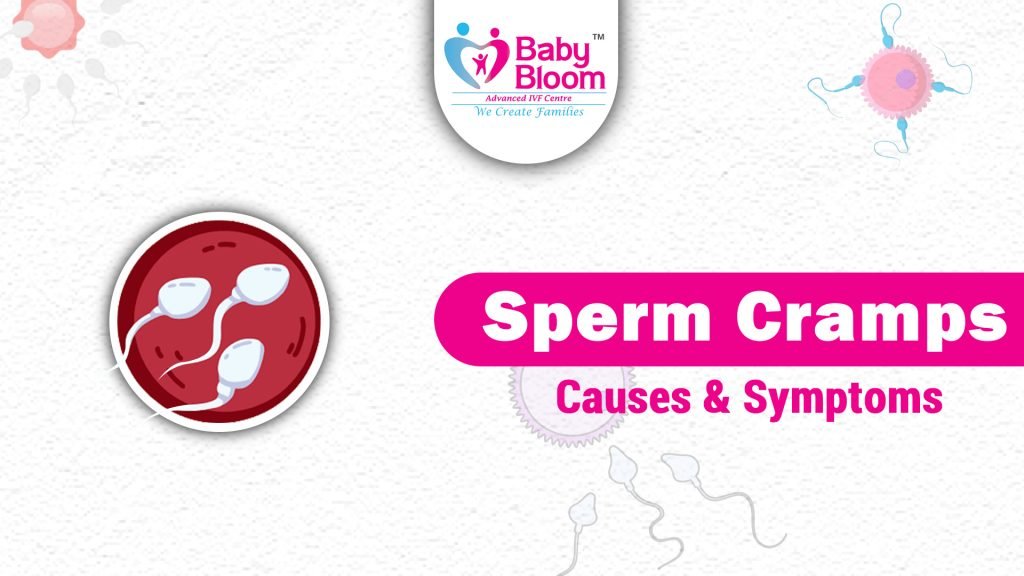Understanding Sperm Cramps: Signs, Causes, and Home Remedies That Work

Dr. Pujil Gulati, IVF Specialist with over 9 years of experience in Assisted Reproductive Techniques BabyBloom IVF Gurgaon
Sperm cramps, although not a commonly discussed topic, are a real condition that can affect men of all ages. These cramps often cause pain or discomfort in the testicles, groin or lower abdomen, and can be worrying for those who experience them. In this article, we will look at what sperm cramps are, their symptoms, possible diagnoses, prevention strategies, risks, and available treatments and options.

What are sperm cramps?
Sperm cramps, also known as testicular torsion or testicular pain, refer to uncomfortable sensations or feelings in the testicles that may indicate pain. These cramps can be sharp, dull or throbbing and may be intermittent or continuous. The pain can sometimes radiate to the lower abdomen, groin or lower back. While this is not a condition that specifically affects sperm production, the discomfort may be linked to issues related to the fertility system
If you are experiencing sperm cramps, it is important to consult a health care professional for a proper diagnosis. They will perform all the tests to determine if the lump is in fact a sperm or another condition that requires medical attention. In most cases, sperm cramps do not require any treatment. However, if they become bothersome, or interfere with your quality of life, your doctor may recommend options such as observation, aspiration (removal of fluid with a needle) or surgery
Symptoms of Sperm cramps
Sperm cramps can present in different ways, and the symptoms can vary in both intensity and duration. Common symptoms include:
- Testicular pain: It feels like a sharp, throbbing, or dull pain in one or both testicles..
- Groin discomfort: You may feel pain or pressure in the groin area, most often radiating from the testicles.
- Lower abdominal pain: Cramping or discomfort in the lower abdominal area often defines testicular pain.
- Swelling or tenderness: your testicles look swollen and feel sensitive to the touch
- Radiating pain: In these cramps, your discomfort may spread to the lower back or thighs..
- Discomfort during ejaculation: There may also be pain or discomfort during or after ejaculation.
- Difficulty sitting or standing: The pain may intensify if you stand or sit for a long time
What are the causes of sperm cramps?
Several factors can lead to sperm cramps. It’s important to identify the root cause for effective treatment. Some of the most common causes include:
1. Pelvic Muscle Stress:
Your pelvic floor muscles are involved in ejaculation. If these muscles are tight or spasmodic when you ejaculate, it can cause pain or discomfort in your genital area, resulting in what some people call sperm cramps. (Read More – Rasoli Kya hoti h)
2. Epididymitis
Inflammation of the epididymis, the tube located behind the testicle that stores and transports sperm. This condition often results in testicular pain and is most often caused by bacterial infection, including sexually transmitted infections (STIs) such as chlamydia and gonorrhea.
3. Varicocele
A varicocele indicates swelling of the veins in the scrotum, similar to varicose veins in the legs. This condition can cause persistent, dull pain and affect sperm production.
4. Prostate Problems:
Sperm cramps can be caused by prostate problems such as enlargement or inflammation. This is also because the prostate gland is located close to the sperm ducts. Since the prostate is very close to these ducts, any problem with it can cause sperm cramps.
5. Testicular torsion:
This is a medical emergency that occurs when the spermatic cord becomes twisted, restricting blood flow to the testicle. This causes sudden and intense pain and requires immediate surgical intervention to avoid permanent damage.
6. Medications:
Some medications, such as antidepressants and antihistamines, cause side effects that can cause muscle cramps or other discomfort. If you’re struggling with semen cramps and have recently started new medications, it’s important to talk to your healthcare provider.
Diagnosis of sperm cramps
Accurate diagnosis is crucial for identifying the right treatment for sperm cramps. When you come to Babybloom IVF Center, our specialists will perform a comprehensive evaluation, which may include:
1. Physical examination:
A thorough check of the testicles, scrotum, and groin area to look for any irregularities, swelling, or tenderness.
2. Medical history
A review of your medical background, including any past infections, injuries, or surgeries. (Read More- Isha Ambani IVF Pregnancy Journey)
3. Ultrasound:
A scrotal ultrasound might be done to visualize the internal structures of the testicles and identify issues like varicocele, hydrocele, or testicular torsion.
4. Urinalysis and Blood Tests:
These tests are used to detect infections or inflammation that may be causing the pain.
5. Sexually Transmitted Infection (STI) screening:
If there’s a suspicion of an STI, relevant tests will be performed to confirm the diagnosis.
6. Advanced imaging:
In certain situations, advanced imaging methods such as MRI or CT scans may be required to exclude more serious conditions.

Treatment options for sperm cramps
The approach to treating sperm cramps varies depending on the root cause. At BabyBloom IVF Center, we create tailored treatment plans that align with the specific diagnosis. Some common treatment options include:
- Antibiotics: If a diagnosis of an infection like epididymitis or prostatitis is made, doctors may prescribe antibiotics to clear the infection and relieve symptoms.
- Pain management: Over-the-counter pain relievers such as ibuprofen or acetaminophen can effectively alleviate pain and decrease inflammation. In certain situations, prescription pain medications might be required.
- Surgical Intervention: Conditions such as testicular torsion or varicocele may necessitate surgical procedures. Testicular torsion requires urgent surgery to untwist the spermatic cord and restore blood flow, whereas varicocele might need a procedure to close off the affected veins.
- Supportive measures: Wearing supportive underwear, using cold compresses, and steering clear of strenuous activities can help alleviate pain and swelling.
- Treatment for a hernia: If an inguinal hernia is the source of the pain, surgery might be necessary to fix the hernia and alleviate the discomfort
- Treatment for hydrocele: If a hydrocele is large or causes discomfort, a doctor may suggest surgical drainage or removal.
- Lifestyle modifications: Making lifestyle changes can be helpful in some situations. This includes avoiding long periods of sitting or standing and steering clear of activities that worsen the pain.
How to prevent sperm cramps?
1. Practice good hygiene: To prevent infections that can lead to sperm cramps, it’s essential to practice good genital hygiene. Make sure to keep the area clean and dry, and steer clear of harsh soaps or irritants that could disrupt the delicate balance.
2. Avoid fitted clothes: To reduce the risk of sperm cramps, it’s helpful to wear loose-fitting underwear and clothing. Tight garments can restrict blood flow and put extra pressure on the pelvic muscles, which can make the condition worse. Choosing looser clothing can help lessen tension and compression in the pelvic area.
3. Avoid tobacco and illicit drugs: Using tobacco and illegal drugs can interfere with sperm production and lead to sperm cramps. Steering clear of these substances is essential for maintaining a healthy reproductive system and preventing sperm cramps.
4. Healthy lifestyle choices: Maintaining a healthy weight, engaging in regular exercise, and steering clear of tobacco and excessive alcohol can all play a significant role in supporting overall reproductive heal
5. Practice safe sex: Using condoms and engaging in safe sex practices can help reduce the risk of sexually transmitted infections (STIs), which are a frequent cause of epididymitis and testicular discomfort. ( Read More – 10 Indian Celebrities Who Chose Egg Freezing)
Conclusion:-
Understanding sperm cramps and their causes is essential for proper diagnosis and treatment. Although sperm cramps can be uncomfortable and concerning, they are usually manageable with appropriate medical care. Taking preventive measures and seeking early intervention are vital for maintaining reproductive health.
At babybloom IVF, we are dedicated to helping you manage your reproductive health with assurance. If you are experiencing symptoms of sperm cramps, please don’t hesitate to contact us for a consultation—your health and well-being are our highest priorities. Start your journey towards relief and peace of mind by scheduling an appointment with our experienced team today. Reach out to us to book your consultation now.
Welcome to BabyBloom IVF, where your journey to parenthood is nurtured with care, expertise, and the latest advancements in fertility treatment. Located in the heart of Gurgaon, Babybloom IVF is the Best IVF Centre in Gurgaon & leading fertility center dedicated to helping couples achieve their dreams of starting or growing their families.
Contact Us
Address No.1 I, block, 189, near Baani Square, South City II, Sector 50, (Gurgaon) Gurugram, Haryana 122018
Address No.2 Babybloom IVF, Nursing Home, Civil Rd, Company Bagh, Rohtak, Haryana 124001

Brought Happiness to the world
@BabyBloom IVF All Rights Reserved @2025


